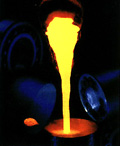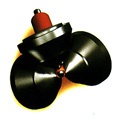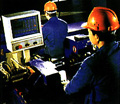|
Types of Copper Tube
  Table 1, Indentifies the seven standed types of copper tube and their also shows the ASTM Standed appropriate lengths, sizes and tempers. Table 1, Indentifies the seven standed types of copper tube and their also shows the ASTM Standed appropriate lengths, sizes and tempers.
Types K, L, M, DWV and Medical Gas tube are designated by ASTM standed sizes, with the actual outside diameter always 1/8 inch larger than the standed size designation. Each type represents a series of size with different wall thicknesses, Type L tube, and Type L walls are thicker than Type M, for any given diameter. All inside diameters depend on tube size and wall thickness.
 Copper tube for air-conditioning and refrigeration field service (ACR) and natural gas (Type G) are designated by actual outside diameter. Copper tube for air-conditioning and refrigeration field service (ACR) and natural gas (Type G) are designated by actual outside diameter.
  "Temper" describes the strength and hardness of the tube. In the piping trades, drawn temper tube is often referred to as "hard" tube and annealed as "soft" tube. Although drawn tube may also be furnished in a "bending temper," it is not covered by ASTM B 88. This special temper of intermediate strength and hardness may be specified for applications requiring bending. Tube in the hard temper condition can be joined by soldering or brazing, using capillary fittings or by welding. "Temper" describes the strength and hardness of the tube. In the piping trades, drawn temper tube is often referred to as "hard" tube and annealed as "soft" tube. Although drawn tube may also be furnished in a "bending temper," it is not covered by ASTM B 88. This special temper of intermediate strength and hardness may be specified for applications requiring bending. Tube in the hard temper condition can be joined by soldering or brazing, using capillary fittings or by welding.
  Tube in the bending and soft tempers can be joined by the same techniques and also by the use of flare-type and compression fittings. It is also psssible to expland the end of one tube so that it can be joined to another by soldering or brazing without a capillary fitting--- a procedure that can be dfficient and economical in many installations. Tube in the bending and soft tempers can be joined by the same techniques and also by the use of flare-type and compression fittings. It is also psssible to expland the end of one tube so that it can be joined to another by soldering or brazing without a capillary fitting--- a procedure that can be dfficient and economical in many installations.

|
 Long lasting copper tube is a favorite ching for plumbling, heat, cooling and other systems. Tube manufactured in the United States is governed by specifications established by the American Society for Testing and Materials (ASTM).
Long lasting copper tube is a favorite ching for plumbling, heat, cooling and other systems. Tube manufactured in the United States is governed by specifications established by the American Society for Testing and Materials (ASTM).




 Table 1, Indentifies the seven standed types of copper tube and their also shows the ASTM Standed appropriate lengths, sizes and tempers.
Table 1, Indentifies the seven standed types of copper tube and their also shows the ASTM Standed appropriate lengths, sizes and tempers.

